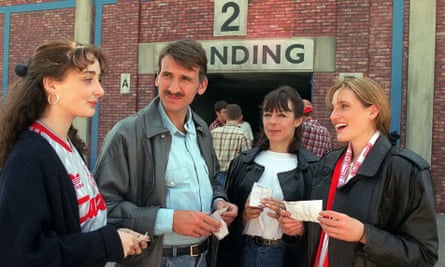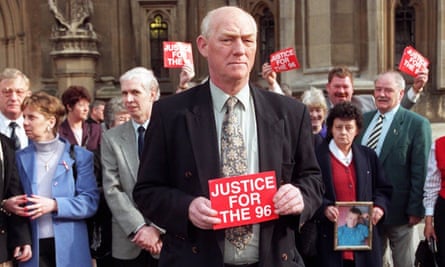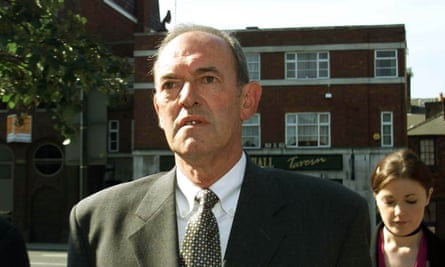27 March 1989
South Yorkshire police chief constable Peter Wright replaces Ch Supt Brian Mole, the experienced commander of football matches at Sheffield Wednesday’s Hillsborough ground. Wright promotes David Duckenfield, who had never commanded a match at Hillsborough before, in Mole’s place.
15 April 1989
Nineteen days after Duckenfield is appointed, 54,000 people come to attend the FA Cup semi-final between Liverpool and Nottingham Forest. In the lethal crush, 96 men, women and children are fatally injured.

1 August 1989
Lord Justice Taylor’s official report into the disaster emphatically blames police mismanagement of the event and criticises South Yorkshire police for blaming Liverpool supporters instead of accepting responsibility. Wright states that he fully accepts the findings.
30 August 1990
The Crown Prosecution Service decides there is insufficient evidence to justify criminal proceedings against anybody from any organisation for any offence arising out of the deaths.
October 1990
South Yorkshire police admits it was negligent and failed in its duty of care to the people attending the match when settling civil claims brought by bereaved families and injured people.
19 November 1990
First inquest opens in Sheffield, heard by the local coroner, Dr Stefan Popper. South Yorkshire police renew their case that drunk supporters who arrived late and ticketless were to blame.

28 March 1991
Inquest jury returns a majority verdict of accidental death.
29 October 1991
With police disciplinary action proceeding against Duckenfield, he retires on medical grounds, diagnosed with depression and post-traumatic stress disorder. His retirement stops the disciplinary action and enables him to receive a full pension, which is being paid to this day.
13 January 1992
The only other disciplinary action, against Supt Bernard Murray, the police control box commander at Hillsborough, is dropped. It is deemed to be unfair to continue to discipline Murray, because Duckenfield is no longer facing charges.
5 November 1993
A judicial review application by six representative families to quash the inquest verdict is rejected by Lord Justice McCowan in the divisional court. McCowan rules that the inquest was properly conducted. Families continue to campaign for justice.

5 December 1996
ITV broadcasts a drama documentary written by Jimmy McGovern, researched by journalist Katy Jones, which powerfully highlights the families’ complaints of injustice and allegations of a police cover-up.
30 June 1997
The new Labour government orders the “scrutiny” of new evidence by Lord Justice Stuart-Smith. It is found that South Yorkshire police changed 164 officers’ accounts of the disaster before sending them to the Taylor inquiry. According to a civil service note (pdf) that became public in 1997, the then home secretary, Jack Straw, did not believe there was sufficient evidence for a new inquiry but said such an assertion had to come from an independent source such as a judge to be “acceptable”. The then prime minister, Tony Blair, had written across the note about setting up a new inquiry: “Why? What is the point.”

13 February 1998
Stuart-Smith rejects any grounds for prosecutions or quashing the inquest verdict. Straw accepts that conclusion.
August 1998
Having raised funds with a concert, the Hillsborough Family Support Group mounts a private prosecution of Duckenfield and Murray.
24 July 2000
Murray is acquitted in the private prosecution at Leeds crown court; the jury does not reach a verdict on Duckenfield, who has exercised his right not to give evidence. The judge, Mr Justice Hooper, rules that Duckenfield should not face a retrial.

12 April 2009
Twenty years after Hillsborough, the Guardian highlights the families’ ongoing grievances and complaints of injustice. Then Labour ministers Andy Burnham and Maria Eagle resolve to call for all documents relating to the disaster to be published.
15 April 2009
Burnham’s speech to the 20th anniversary memorial service at Anfield is interrupted with calls from the crowd of “justice for the 96”. His call for disclosure is supported by Gordon Brown’s government.
12 September 2012
The Hillsborough Independent Panel, which has reviewed 450,000 documents disclosed to it, publishes its report. The police failings are highlighted, and their campaign to blame supporters further exposed. The Conservative home secretary, Theresa May, accepts the report and orders a new criminal inquiry into the disaster, Operation Resolve. The Independent Police Complaints Commission launches an investigation into alleged malpractice by the police in the case made afterwards.

19 December 2012
The verdict in the first inquest is quashed by the lord chief justice, Igor Judge, and two other judges, who find that it was not properly conducted.
31 March 2014
The new inquests begin in Birchwood, Warrington. Together they become by far the longest case ever heard by a jury in British legal history.
26 April 2016
The inquest jury delivers its verdict. Among the 14 questions it is asked to decide upon, it concludes:
- The 96 people who died in the disaster were unlawfully killed, overturning the verdict of accidental death at the original inquest.
- No behaviour on the part of Liverpool fans contributed to the dangerous situation at the Leppings Lane turnstiles. This, at last, comprehensively exonerates the supporters who were blamed for causing the disaster in its immediate aftermath.
- Defects in the construction and layout of the stadium contributed to the disaster.
- “Errors and omissions” by the commanding police officers and the entire police operation on the day contributed to the causes of the disaster.
- Errors and omissions in the stadium’s layout and design, and its lack of a valid safety certificate contributed to the tragedy, as did Sheffield Wednesday FC’s preparation for the match. On the question of whether the club’s actions on the day of the game were a contributory factor, the jury could not say for sure but said they may have been
- Errors and omissions by the South Yorkshire metropolitan ambulance service contributed to the disaster.